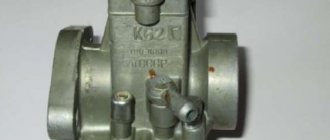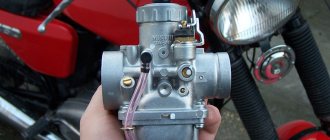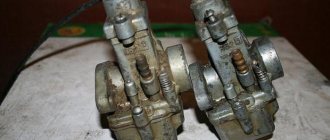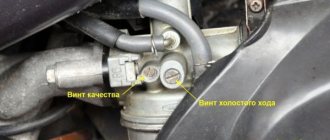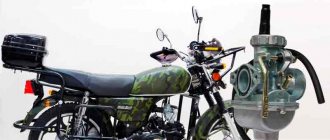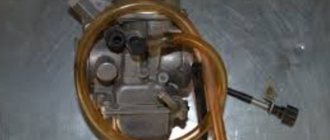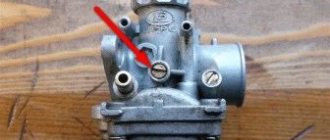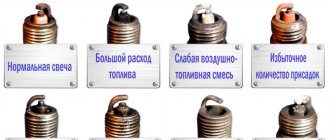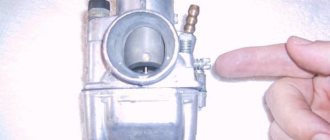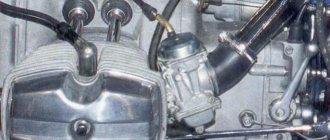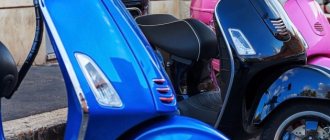Former Leningrad carburetor, since 1993.
began production of a new generation of motorcycle carburetors K-68. They were somewhat different from their predecessors in design terms, as well as in their functionality and efficiency. This model, in various modifications, began to be equipped with Ural, IZH, and Dnepr motorcycles. And today the K-68 has not lost its relevance and is rightfully considered one of the best domestic models for motorcycles. In this article we will look at the main types of adjustment of the K-68 carburetor, with the help of which anyone can achieve good dynamics, efficiency and proper operation of the entire power unit. For those who do not know how to adjust the carburetor on a scooter, this article will also be useful.
Basic types of carburetor settings
It is no secret to any car owner that the carburetor is designed to prepare a combustible mixture for the engine, which it produces by mixing a certain portion of air with fuel. But its functions are not limited to this. It must also ensure that the motorcycle engine operates in different modes, which means preparing a fuel mixture with different proportions of its components. The implementation of this task is entrusted to various systems and components of the device. These include:
- Main dosing system;
- Idle system;
- Starting device;
- System for maintaining a given fuel level.
We will look at setting up these elements. The best place to start is by checking the fuel level in the float chamber.
. To do this you need:
- remove the carburetor;
- remove the float chamber cover;
- Having turned the carburetor over so that the floats are on top, measure the distance from the edge of the body to the top edge of the floats. It should be 26 mm ± 0.5 mm; in case of deviation, it is eliminated by bending the tongue;
- check the parallelism of the floats; adjust by bending the brackets.
Now let's move on to the main dosing system.
. First, check the gap between the throttle valve and the bottom of the air duct. It should be 2 mm. If the gap does not match, then adjust it using the throttle valve cable adjusting bolt, which is located on the throttle well cover tube.
The next step in adjusting the K-68 carburetor is to check the position of the throttle needle
. It has 5 grooves into which the needle lock can be inserted. The normal position of the lock is the middle groove. Moving the lock downwards makes the mixture richer, upwards - on the contrary, it becomes leaner. We check by the color of the central electrode of the spark plug:
- if the electrode is black or dark brown, this means that the combustible mixture burning in the cylinder block is highly enriched - move the lock down;
- if the color is light gray, it is depleted - raise the lock;
- The light brown color of the electrode indicates the normal position of the needle.
- We tighten the mixture quality screw until it stops, and then unscrew it one to one and a half turns;
- By rotating the throttle lift screw, we achieve a reduction in speed to the minimum stable;
- Using the quality screw, we bring the engine to maximum speed;
- Again, use the throttle lift screw to reduce the speed to minimum. This operation must be carried out several times until you achieve stable engine operation at the leanest possible mixture;
- Turn the quality screw ½ turn.
Finally, the K-68 carburetor has been adjusted. If everything is done correctly, then there is a full guarantee that with the remaining systems in working order and debugged, the motorcycle will start confidently and operate reliably in any mode, delivering true pleasure to its owner.
IZh Planet motorcycle carburetor 4 malfunctions and their elimination
A K62I brand carburetor is installed on the engine of the IZH Planet 4 motorcycle. Like all motorcycle components, the carburetor performs a certain most important job.
The main goal is to prepare a high-quality mixture from air and fuel (gasoline) for engine operation.
In what ratio this mixture will be created will depend on the operation of the engine, its power, throttle response and easy controllability of not only the engine, but also the entire motorcycle. And the fuel tap and air filter are responsible for the purity of the fuel mixture.
The carburetor consists of body 1 and two covers, upper and lower. Body 1 of the carburetor is the base on which all carburetor parts are mounted, and also inside the carburetor body, channels are drilled through which air and fuel pass; using adjusting screws and special jets in the channels, air and fuel are mixed in certain proportions.
At the bottom of the carburetor, a cover is attached with two bolts, which is the body of the float chamber. The float chamber plays a critical role in engine operation; with the help of float 6 and needle 7, it automatically regulates the fuel supply to the carburetor to a certain level, which in turn affects engine operation.
The main malfunction of the float chamber is that when the fuel tap is opened, the fuel spontaneously overflows the carburetor and flows out. First of all, we check the needle 7 for the presence of the o-ring 8 on it and its condition.
How to adjust the K-65 carburetor?
One of the important systems of motorcycles is the carburetor. He is responsible for the correct operation of the vehicle, its stability and durability. The functionality of a motorcycle or scooter largely depends on the design features of the carburetor. Therefore, the owners of the presented vehicles evaluate the design features and operating principle of this device.
Often, when creating domestic brands of motorcycles, mopeds and even snowmobiles, the manufacturer installs a K-65 carburetor in the system. You can adjust it yourself if necessary. The setting will allow the engine to start simply and easily, its operation will be stable and smooth. The fuel mixture will consist of the correct proportion of components.
general characteristics
The K-65 type device was created on the basis of the K-62 carburetor. The previous model had a number of shortcomings. Because of this, frequent breakdowns occurred in the system. The designers took into account all the shortcomings. They have developed a completely new design that is more durable and reliable.
The K-65 carburetor is installed on IZH Planet 5, Ural, Minsk, Buran snowmobile, etc. This is one of the most popular types of devices presented. Its adjustment is not very difficult. In case of uneven engine operation or incorrect proportions when preparing the fuel mixture, you must perform the procedure yourself.
The technology for carburetors of various brands of motorcycles and scooters is produced according to an identical scheme. To ensure stable, long-term operation of the motor, you will need to read the step-by-step instructions for this process.
Izh planet 5 ignition adjustment, how to set it up correctly
Izh Planet 5 is the brainchild of the Izhevsk Machine-Building Plant. Its production was discontinued in 2008, and the model itself entered the assembly line back in 1987.
Accordingly, in any case, the bikes that are traveling on our roads are far from brand new. But they are reliable in service, so we will see this model on our roads for many more years.
Izh Planet 5, the ignition adjustment of which is described below.
It goes without saying that with age, any technology develops certain problem areas. Izh Planet 5, in principle, does not create extremely problematic situations for its owner, but it does have a weak point - ignition.
In order to figure out how to adjust the ignition on Izh Planet 5 and be able to fix the problem yourself if necessary, you need to have a certain tool, time and a little optimism. The first time it may be a little difficult, but as they say, the master’s work is feared.
First you need to remove the crankcase cover, but you can get by by removing only the generator cover. In the first case, it will be more convenient to do subsequent work.
The tool you will need is a caliper or a feeler gauge, but in the absence of such, you can make an analogue of a depth gauge using a handy tool (screwdriver), the feeler gauge is needed to measure the gap.
We connect the control light to the terminal. We turn the spark plug out after turning on the ignition.
We take the crankshaft by the generator bolt and turn it in the direction of movement of the clock hand until the moment when the breaker contacts are maximally open, after which you should loosen the screw, turn the eccentric and set the intercontact gap to approximately 0.5 mm.
Tighten the screw. We lower a caliper micrometer (or its equivalent) into the cylinder. Carefully turning the crankshaft, we find the top dead center (TDC) by performing rotations in the direction of movement of the hand on the clock. We fix or mark this position on a micrometer (screwdriver). Let's measure and record a 3.5 mm mark on the micrometer. below the original mark.
After which it is necessary to turn the crankshaft in the opposite direction until the piston stops with a micrometer (screwdriver, feeler gauge), while the piston should not cross the 3.5 mm line from top dead center (TDC).
Opening of contacts can be easily determined using a probe, one edge of which is connected to ground, and the other to the breaker hammer terminal. Turning on the ignition is accompanied by a light bulb, which indicates that the contacts have opened.
When you have neither a rod nor a probe at hand, try to trust your own eye, using available materials, move the eccentric with a wrench so that the contacts open as wide as possible. Loosen the screw securing the moving contact and use the eccentric screw to adjust the gap to 0.4 - 0.5 mm.
Find a 10 cm ruler that can fit into the spark plug hole, and rotate the armature with a wrench, gradually bringing the piston to TDC. Place a ruler against the piston, make a mark on it that coincides with the edge of the spark plug hole, and the next mark 3.5 mm higher than the previous one.
Rotate counterclockwise until the edges of the spark plug hole line up with the second mark. Lock it in. The ruler, of course, must be removed.
Now you need to place the spark plug on the ribs of the head , while loosening the two screws securing the contact pad, turning on the ignition, carefully move the pad from side to side to find the optimal position at which it will be possible for a spark to occur between the contacts and the spark plugs.
The site is fixed. We check the correctness of the adjustment - rotate the armature by the bolt, after turning on the ignition. A spark will appear at the moment when the piston is 3.5 mm from TDC. This was our second mark.
To prevent the engine from starting to work in the opposite direction after the piston rises to TDC, it is necessary to turn the crankshaft in the opposite direction until the piston is lowered below TDC by 2-3 mm. This procedure increases efficiency.
Today, many owners replace the standard ignition with electronic ignition on the Izh Planet 5. The installation of the BSZ on Izh Planet 5 can be carried out without dismantling the cam system, but it significantly improves all characteristics and facilitates operation. The road is waiting for you.
Source: https://MotoZnai.ru/otechestvennye-motocikly/izh-planeta/regulirovka-zazhiganiya.html
Design
The K-65 carburetor of the Ural, IZH, Minsk, etc. motorcycles is characterized by a certain design. The system maintains a constant level of fuel in the combustion chamber. The fuel mixture reaches the fuel valve through the fitting. The shut-off valve has an elastic washer. The valve is connected to plastic floats. They are connected to each other. The floats can rotate.
When the fuel level rises, the excess will be drained through the drain hole. When heated, pressure may increase. To reset its excess, the design provides an unbalancing channel.
The metering device includes a sprayer, a fuel nozzle, a throttle needle, and an air channel. The first of these components is secured with a washer. It is located under the fuel supply pipe. This hose is one of the main components of the idle air system. It also includes an air channel, fuel mixture adjustment screws, and a transition hole.
How to Adjust the Carburetor on Izh Planet 5
How to install and adjust the carburetor on Izh Jupiter 5
Jupiter 5 is one of the more successful creations of Russian motorcycle production. Now, like 30 years ago, the device is often found on the streets of both remote outbacks and large cities, and the owner almost always prefers to service it without the help of others.
The carburetor , being one of the important components of any motor vehicle, is subject to intense use and excessive wear. Taking into account the great age of some models, replacing this module very often becomes an inevitable condition for extending the life of the unit.
The bike is equipped with Izhevsk carburetors K-62D, K-65D, K-68D , or the Czechoslovakian model Jikov-2928SE . There are few differences between the first two options: the design of the top cover; enrichment jet diameter; needle fastening (K-65D comes with a nozzle). The K-68D differs from its predecessor:
- Enlarged diffuser.
- A round (not square, like the K-65) damper.
- Lateral (more convenient for optimization) location of the idle screw
. - Threaded (for quick needle adjustment) top cover.
Which carburetor on IZ Jupiter 5? As you can see, the 68th model is more convenient to maintain , however, experienced motorcyclists note that it often contains defects, for example, in the form of the absence of a hole that improves the formation of the fuel mixture.
System operation
When adjusting the K-65 carburetor on Minsk, Ural, etc., it is necessary to understand the operating principle of the entire system. Its design has been discussed in detail above. The fuel is in the tank. From the float chamber it enters the sprayer through the main jet. This process occurs under the influence of rarefaction.
The fuel rises along the gap between the throttle needle and the nozzle. At the outlet, gasoline is mixed with air, which enters through the channel of the atomizer body. Engine operation is controlled by the throttle needle. It can be installed in one of the five positions provided.
At idle, the fuel mixture exits only through a special hole. As the speed increases, the vacuum increases. In the area of the next hole, the fuel mixture also exits. As the engine speed increases, the flow of fuel into the system increases.
General recommendations
When considering how to set up a K-65 carburetor, it is necessary to take into account a number of general recommendations. They must be performed before the process. All setup work must be carried out in accordance with the manufacturer's instructions. For owners of the presented vehicles who do not have experience in making adjustments, it is recommended that before starting work they carefully study all the requirements of the device creators.
The carburetor must be in good working order. If there is any abnormality in its system operation, it is necessary to carry out system maintenance.
If necessary, the system will need to be thoroughly cleaned. All consumables are replaced with new seals. The air filter must be clean. If necessary, it must be washed. In some cases it will need to be completely replaced.
When adjusting the carburetor, the engine must be warm. To do this, you can drive several kilometers along the highway. Only after this can you begin the procedure described below.
Setup procedure
Setting up the K-65 carburetor in various vehicles is done using a certain technology. Stable, smooth operation of the engine, fuel consumption, and engine durability depend on the correct execution of all stages of the process. Therefore, this process must be approached responsibly.
First of all, the correct proportion of the fuel mixture is adjusted. To do this, first measure the gasoline level in the float chamber. If there are abnormalities in this system, the mixture may be too lean or too rich. If the ratio of air to gasoline is not maintained correctly, problems will develop in many systems over time.
Next, you need to configure other carburetor devices. The main dosing system is being adjusted. The driver must pay attention to the trigger mechanism. The engine speed is adjusted at idle speed. By consistently performing these actions, you can achieve stable, high-quality operation of all motorcycle systems.
Stop valve
When checking the K-68 carburetor, you should pay attention to the shut-off valve. This valve has another name - a needle. It is he who can get a rich mixture due to the fact that the valve is not tightly attached.
The needle-type valve contains a rubber ring in its assembly. During the inspection, you can pay attention to the condition of this element. To do this, you need to remove the cover, which is located at the bottom. It is secured with two bolts. When removing these elements, you need to ensure that the gasket is not damaged.
After this, you need to remove the float. To achieve this, you need to squeeze the float rod out of the grooves. During this process, you need to watch the needle, as it can easily fall. Notice how the needle moves along the saddle. If the movement occurs without failures, then everything is normal. If the ring is worn out, it is necessary to replace this element.
Fuel level
Adjusting the K-65 carburetor begins with measuring the amount of gasoline in the tank of the float section. To do this, you will need to prepare a certain list of tools. Almost every home craftsman has them. The tool will be required during the process of dismantling the carburetor.
When the device is removed from the slots, you will need to remove the cover from it. It covers the float chamber. Next you need to take a ruler. The float has a special tongue. It needs to be unbent and bent to make adjustments. Due to this, the fuel level in the chamber will change.
You will need to place a ruler on the connector plane. Next, the tongue must be adjusted correctly. The strip on the float should be at 13 mm. The deviation is ±1.5 mm. The floats themselves must be level. The adjustment must be made very precisely. The operation of the carburetor depends on this.
Causes of overflow
Let’s say that there is no doubt that the carburetor began to pour gasoline mercilessly
What to do next? First of all, it is important to determine the cause of the problem. By answering the question “Why is the carburetor flooding?”, any vehicle owner will be able to fix the problem on their own
Often the cause of such a breakdown is one of the following:
- There is a malfunction in the needle valve. A similar “sore” often affects the carburetor on a moped and similar components on a trimmer or similar devices. A malfunction of the needle valve often occurs due to its loss of a sealed state, in which it promptly and completely closes the fuel channels, thereby dosing its supply. If the valve is heavily worn or “stuck” in the open position, gasoline overflows cannot be avoided. This unit can be checked for correct functioning by supplying discharged air to it; during normal operation, the needle should stably close the fuel paths and not allow air to pass through;
- The float in the float chamber is either leaking or touching the walls of the carburetor. The owner of any carburetor unit is not insured against this kind of problem. You can check the normality of the float by removing the float chamber cover and conducting a detailed inspection of the unit;
- The level in the float chamber has increased or the one that was present all the time has ceased to be relevant. This often happens when a motorcycle, moped or car has had a faulty component for a long time that increases fuel consumption. The part has been replaced or successfully repaired, but gasoline continues to be supplied in the same quantities. As a result, it turns out that the carburetor is “flowing”. Checking for the presence of such a problem is carried out exclusively by an empirical method, that is, by “playing” with the fuel level in the float chamber;
- The fuel pump is faulty. Perhaps this is also a problem from which it is impossible to insure yourself. It appears for only one reason - the fuel pump has failed due to some of its elements. In such a situation, all that remains is to disassemble, inspect and repair the broken part;
- The check valve that returns gasoline to the fuel line when there is overflow in the float chamber has broken down. Relevant for any Solex carburetor and similar components. You can check for a problem with the “return” by disassembling it, visually inspecting it, and blowing it with compressed air. If such manipulations do not correct the situation and no other problems are observed, then you should think about replacing the check valve.
The reasons described above for the carburetor overflowing on a scooter, car or other unit occur in 80-90% of all cases during a breakdown of this kind. Much less often, gasoline overflow occurs due to a malfunction or incorrect configuration of individual elements of the fuel distribution unit. Mainly affected are rubber nozzle seals, power mode economizers, throttle valves, solenoid valves, carburetor gaskets and mixture quality adjustment screws. The functioning of these elements is checked by disassembling the carburetor and inspecting it in detail, followed by subsequent repair measures.
Setting up on the Ural
Adjusting the K-65 carburetor on the Ural motorcycle has several distinctive features. The entire unit does not need to be removed from the vehicle. Dismantling this type of vehicle can be very difficult. Therefore, the procedure is carried out directly on the motorcycle.
To adjust the gasoline level in the float chamber, you will need to find a similar element from another similar motorcycle. The vehicle is firmly installed on the stand. The gas valve gradually opens. Fuel flows into the carburetor. The hose is disconnected and the gas tap is closed.
The bottom cover filled with fuel is removed. By comparing the fuel level, a conclusion is made about the need for adjustment. The tongue can be bent.
This is interesting: Do-it-yourself dent repair without painting
Candles
The K-65 carburetor for IZH, Ural and other brands of motorcycles must have the corresponding appearance of the spark plugs. A visual inspection is sufficient. If a new carburetor is installed, you will need to drive a motorcycle or scooter on the highway for about 30 km. Engine speed should be high or medium.
After this, you can put the vehicle in the garage and begin inspecting the spark plugs. Soot should not appear on their surface. If this happens, there is not enough air in the mixture. Such fuel is called rich. The spark plugs will need to be cleaned before tuning.
In some cases, the surface of the candles turns white. This picture is observed when the system prepares a mixture that is too lean. There is too much air in it. The normal color of candles should remain in the range of yellow to reddish-orange. In this case, no configuration is required.
Adjusting the K62 carburetor:
Hello! Please tell me, I have a Minsk 125, it’s a Pakko (original, new), it’s not in use, it works fine, that is, the idle is normal, it picks up speed briskly, but as soon as you start to move out of place, it doesn’t pull well, or it may even stall, you just need gas open more than halfway. The quality screw is screwed in completely, but if you unscrew it by 1-1.5 rpm, you won’t be able to move it at all - the engine will stall. The spark is normal, the ignition is set correctly, the needle is in the middle position. Please tell me what’s wrong, this is the first time I’ve encountered such a problem?
Did you use the carburetor before or did you just install a new one?
I have an Izh P3 Minsk ignition that runs on a choke and doesn’t hold idle, and when you move from place to place, it’s like a splash, you add half the gas, then it goes, what’s wrong?
started a long time ago? CARBURETOR K 62? HOW DID YOU WORK BEFORE?
Throttle needle
When studying the technology of how to adjust the K-65 carburetor, you need to pay attention to the shut-off valve. This is the throttle needle. If it does not cover the channel hermetically, the level of gasoline in the fuel mixture may be higher than the required level.
The throttle needle has several channels on its surface. The latch moves along them. In this case, it is possible to adjust the composition of the fuel mixture within small limits. The gasoline consumption of motor vehicles depends on this indicator. If you need to add more air to the mixture, you need to lower the needle. And vice versa.
When dismantling the float chamber, it is necessary to monitor the position of the throttle needle. If you move it carelessly, it may fall out. There is no way to lose this structural element. Therefore, the procedure is carried out very carefully. If the rubber elements of the throttle system are worn out, they must be replaced. The needle should move easily along the saddle.
Engine starting and heating system
In search of an answer to the question of how to adjust the K 65 carburetor, you should familiarize yourself with the engine starting and heating device.
On carburetors K 65S and K 65V, a starting device with an autonomous drive is installed, on K 65G and K 65Zh - with a cable drive (found in motorcycles "Dnepr", "Ural"), and for K 65I, K 65D - a corrector-heater (often used in IZH brand mopeds).
A starter with an autonomous drive includes a plunger, a trigger, a needle, a protective cap, channels, a control rod, a fuel well and holes. The normal position of the device is considered closed.
The cable-driven starter is very similar to the previous version, with the exception of the presence of a rod. The position of the plunger is adjusted by a cable.
The corrector-enricher is characterized by a functioning system in which fuel enters the starting device from the float chamber. Fuel consumption is limited by the jet. The Soviet K 65 carburetor often has such a device. IZH can serve as an example of such motorcycles.
Idling
The K-65 carburetor is adjusted at idle. The engine must be well warmed up. At idle, the engine should run stably. Use a screwdriver to adjust the horizontal screw. To do this, turn it in the appropriate direction until speed stability is established.
After this, you can tighten the quality screw. A screwdriver is also used for this. When rotating the screw, you must listen to the operation of the motor. The number of revolutions at the maximum level should be stable.
Next, by opening and closing the throttle, the correct idle speed adjustment is checked. If the gas is applied suddenly, the engine will stall if the adjustment was carried out incorrectly. If this happens, the mixture will need to be enriched. At the moment of abrupt closure of the damper, stopping the engine indicates a lack of air in the mixture. The screw is loosened slightly.
Adjusting mixture enrichment
Before starting adjustments, be it the carburetor model K 65 of the Ural, Dnepr motorcycle, Buran snowmobile or other vehicles, the engine should be warmed up.
Then the minimum stable idle speed is set. To do this, use the screw to lower the throttle. Afterwards you need to increase the number of revolutions to the maximum possible. The screw is rotated in one direction or another.
Slowly the speed is again reduced and increased. This should be done 2-3 times.
After the manipulations, you should check how the engine reacts to the position of the throttle. To understand how to set up the K 65 carburetor, you need to determine the required level of enrichment of the fuel mixture for the engine.
To do this, carry out such an experiment. The throttle opens sharply. If the engine stalls, then the mixture should be enriched. To do this, turn the mixture quality screw 1/4 or 1/2 turn.
A stalling engine when the throttle is closed sharply indicates the need to make the mixture leaner. In this case, the mixture quality screw needs to be adjusted by 1/4-1/2 turn.
Dosage system
The K-65 carburetor is adjusted especially carefully in the area of the metering needle. Its position must be carefully adjusted. The engine must be well warmed up. If it has already cooled down, you need to ride the motorcycle for some time on the highway.
On a straight section of the route, you can evaluate the engine's performance. If turning the throttle does not have sufficient effect, you will need to raise the needle. This will lead to an increase in gasoline in the fuel mixture. If after the next trip carbon deposits appear on the spark plugs, you will need to lower the throttle needle one notch.
This approach will ensure stable operation of the engine at medium speeds. This is the most frequently used mode when operating motorcycles. The maximum speed allows you to adjust the measurement of the jet cross-section. When the throttle is turned all the way, it will ensure the operation of the system.
Having considered what the K-65 carburetor is, as well as its structure, you can adjust it in accordance with all the manufacturer’s requirements.
Standard carburetor of a modern engine
Carburetors installed on modern models of scooters, motorcycles and ATVs have the same two adjustment screws, but the quality screw regulates the mixture only at idle speed.
To regulate the quality of the mixture throughout the entire speed range, a metering needle is installed on the throttle valve.
This needle has a locking ring that allows you to raise the needle, thereby enriching the mixture, and lower the needle, thereby leaning the mixture.
We check the correct position of the needle as follows. First, sharply unscrew the throttle handle, the engine should quickly pick up speed without failures. If the engine stalls, the mixture is lean, you need to raise the needle one notch. If there is black smoke, popping sounds are heard in the muffler, the engine does not reach maximum speed - the mixture is rich, the needle should be lowered. Next, after a short run, we can more accurately determine the quality of the mixture based on the carbon deposits on the spark plug and make appropriate adjustments.
Carburetor - removal and disassembly
It is possible to partially disassemble the carburetor (removing and washing the throttle, repairing the drive, etc.) without removing it from the engine.
1. Place the motorcycle on the center stand.
2. Remove the protective covers.
3. Shutting off the fuel supply, disconnect the fuel hose from the carburetor.
4. Use a screwdriver to loosen the clamp and disconnect the rubber air filter pipe from the carburetor.
5. 10 mm
Unscrew the mixture corrector nut.
6. Remove the corrector plunger assembly.
7. Disassemble the corrector plunger.
8. Pulling the cable sheath upward, unscrew the throttle valve cover.
9. Remove the throttle valve assembly. Cover the hole with a clean cloth.
10. To replace the cable, you need to compress the damper return spring, and, pushing the cable down, remove its end from the cut in the damper needle nut.
1. 12 mm
unscrew the two bolts securing the carburetor adapter pipe to the cylinder. We remove the carburetor with the pipe, being careful not to tear the paronite gasket.
2. Hold the bolts with a 12mm
, unscrew the nuts securing the adapter pipe
with a 13 mm
. We remove the pipe.
1. Using a screwdriver, unscrew the two screws securing the carburetor cover.
2. Remove the float chamber. There is a paper gasket underneath, be careful not to tear it.
3. Using a thin drift, carefully knock out the float axis.
4. Use thin pliers to remove the axle.
5. Remove the float along with the locking needle.
8 mm socket wrench
We turn out the seat of the shut-off valve.
7. Using a screwdriver, unscrew the jets of the main dosing system and the idle system.
8. 6 mm
turn out the additional jet.
9. 12 mm
We turn out the fuel-emulsion nozzle of the main dosing system.
10. Turn out the “quantity” and “quality” screws.
13. We wash all carburetor parts, except gaskets and rubber parts, in acetone or solvent for nitro paints. We clean all channels and jets with copper wire or toothpicks soaked in solvent, and blow them with compressed air from the compressor.
It is unacceptable to clean carburetor jets with steel wire, needles or any other tool.
We assemble the carburetor in the reverse order, while lubricating the rubber o-rings, threads and gaskets with engine oil or BSK brake fluid containing castor oil.
We tighten the “quantity” and “quality” screws until they stop. Then we unscrew the “quality” screw one turn (preset), and unscrew the “quantity” screw five to seven turns.
We check the operation of the shut-off valve. When the carburetor is oriented with the throttle channel down, the air supplied by the mouth into the inlet fitting should not pass through the valve.
Adjusting the position of the needle of the main dosing system is carried out by rearranging the lock washer in the grooves of the needle:
- washer to the left - enrichment of the mixture; - washer to the right - lean mixture.
CARBURETOR K65: ADJUSTMENT
For many years, domestic motorcycles and scooters, as well as Buran snowmobiles, were equipped with carburetors of the K62 family or their varieties. Operation revealed a number of design flaws. Their elimination required a major modernization of carburetors and led to the emergence of an essentially new device, which was designated K65. Its implementation began at the end of last year and will be completed this year.
Since the carburetor has a long life ahead of it, we asked the engineers of the Leningrad Carburetor Plant to tell us more about it.
At first glance, the K65 carburetor is not much different from the usual K62. But this is precisely at first glance, since modernization affected not the form, but the content. And you will be convinced of this when, together with us, you examine the structure, principles of operation and adjustment of the new device shown in Fig. 1.
First, let's talk about the design and operating principles.
It all starts with a system of approach and maintaining a constant fuel level. Through fitting 20 it reaches the fuel valve 15, which is equipped with an elastic lock washer. The valve rests on a tongue 18 connected to plastic floats 17, which are interconnected and rotate freely on an axis 16.
If for some reason the fuel level rises, its excess is discharged from the float chamber through the drainage hole 32. To prevent the pressure in the float chamber from increasing when heated, it is connected to the atmosphere by an unbalancing channel 31.
The main dosing system consists of a sprayer 5, a main fuel jet 6, a throttle needle 7 and an air supply channel 8. Fuel from the float chamber through the main fuel jet 6 enters the sprayer 5, rising under the influence of vacuum along the gap between the sprayer and the throttle needle 7. At the exit from the atomizer, it is mixed with air entering through channel 8 through the hole in the atomizer body. The throttle needle ensures engine operation at medium speeds and can be set to one of five positions. At maximum power modes, fuel consumption is determined mainly by the throughput of the main fuel nozzle.
Reliable fastening of the atomizer is ensured by a lock washer 14 installed under the fuel pipe 9.
The idle system consists, in turn, of a fuel pipe 9, an air channel 10, mixture quality screws 11 and mixture quantity 27, idle hole 12 and transition hole 13.
When the engine is idling, under the influence of vacuum in the mixing chamber behind the throttle, the fuel rises through tube 9 and mixes with air entering through channel 10. The resulting emulsion, when the throttle is opened slightly (at low speeds), comes out only through hole 12. With further rise of the throttle and As the speed increases, the vacuum in the area of hole 13 increases and the emulsion also begins to flow through it. Thus, the fuel supply increases as the speed increases.
The main system for starting and warming up the engine. On carburetors of different modifications, different systems of enrichment devices are used: on K65S and K65V - a starting device with an autonomous drive; on K65G and K65Zh - with cable drive; on K65I and K65D - corrector-enrichment. Let's look at them in that order.
The starting device with an autonomous drive consists of a plunger 37, a guide 35, a return spring 36, a starting device needle 39, a sealing rubber 38, a protective cap 29, a control rod 40, as well as channels 33 and 34, a fuel well A and a hole 41.
The normal position of the device is closed. In this case, the needle 39 with the rubber seal 38 blocks the fuel channel, and the side surface of the plunger 37 blocks channels 33 and 34. To turn on the starting device, you need to lift the rod 40 up and turn it approximately 90°. In this case, the extrusions on the rod will come out of the grooves of the guide 35 and will be fixed at its upper end. The plunger will rise, opening channels 33 and 34 and fuel channel 48. Under the influence of vacuum, fuel from well A will enter the cavity under the plunger, mix with air and be fed into the mixing chamber in the form of an emulsion. The volume of fuel in the well is sufficient for a high one-time supply at the time of start. After starting the engine, the fuel level in the well decreases and the composition of the mixture becomes leaner.
This is interesting: Video training for repairing dents without painting
To turn off the starting device, you need, of course, to turn the rod back by about 90°, after which, under the action of the return spring 36, the plunger will take its original position.
The starting device is protected from dust and dirt by a rubber cap placed on the spring guide 35.
The starting device with a cable drive is similar to the DESCRIBED one - but it does not have a rod 40, and the position of the plunger 37 is adjusted by a cable connected to the shifter.
The corrector-enricher differs in that fuel enters it directly from the float chamber (there is no fuel well A). Fuel consumption is limited by jet 43.
With the plunger fully raised, the greatest enrichment of the mixture necessary to start the engine is achieved. As the plunger is lowered, the mixture becomes increasingly lean as the gap between the needle 42 and the channel wall decreases. When the plunger is completely lowered, the needle with rubber seal 38 closes the fuel channel 48.
An additional starting device (float suppressor) is used at air temperatures from +5C and below. Using it requires no explanation.
Having examined the design and operating principle of individual systems, we can now move on to issues of operation and adjustments.
Before installing the carburetor, you need to remove its cover 2 with the throttle assembly. The cover is a rather complex subassembly on which the throttle lift screw 27, guide 28, gasket 26, throttle lift limiter 30, throttle 21 and its spring 24, protective cap 29 are installed. Screw 27 is connected to the throttle by a rod. The throttle spring 24 simultaneously holds the needle 7 through the lock 22.
The U-shaped brass throttle has two shaped holes and one round one. The latter, located in the center, serves to install and fasten the needle, the shaped one on the cutout side is for fastening the throttle cable, and the T-shaped one is for attaching the rod of the screw 27. The radial cutout on the throttle wall, facing the air filter, provides the necessary vacuum in the area sprayer.
There is a limiter 30 inside the cover - it is recommended to remove it after the break-in is completed.
After installing the carburetor on the engine, you need to attach a cable to the throttle and secure the cover to the carburetor. After this, lift the throttle using the throttle and check whether it opens the diffuser completely. Do this several times to ensure that the throttle is not stuck in any position and that the diffuser closes and opens completely. Using screw 27, raise the throttle to a position where a gap of 2-3 mm appears between its lower edge and the diffuser generatrix.
If the carburetor has a starting device or a corrector, you need to unscrew part 35, remove the corrector assembly and attach the cable to the piston 27, and then install the unit in place.
Adjust the position of the stops 28 of the sheaths of the throttle and corrector drive cables (if the latter is present) so that they have a free play of approximately 2-3 mm (this is done so that when the steering wheel is turned, the position of the throttle or corrector does not change).
Screw screw 11 until it stops, and then unscrew it 0.5-1.5 turns. Attach the fuel hose to fitting 20. Make sure that fuel does not leak at the connection points, and open the starter or corrector. If, due to weather conditions or the individual characteristics of the engine, it is necessary to use a float suppressor, it is better to do this while simultaneously opening the throttle fully, then the reception efficiency increases.
Smoothly pressing the kickstarter, turn the crankshaft 2-3 turns, turn on the ignition and start vigorously. After starting and warming up the engine, the starting device or corrector must be turned off.
In conclusion, let's talk a little about carburetor adjustments - every motorcyclist has to deal with them from time to time.
It makes more sense to start by setting the fuel level. To do this, you need to turn the carburetor over, remove the bottom of the float chamber and measure the distance from the plane of the connector to the line dividing the float in half (the mark from the mold connector). This distance should be 13±1.5 mm. If the size of your carburetor does not fall within these limits, you need to carefully bend float tongue 18 in one direction or another.
One more note in passing. If during operation the carburetor suddenly begins to overflow, you need to check whether the float is leaky. To do this, immerse it in a bath of hot water for at least a minute. Bubbles will appear - the float is bad, if not - everything is fine.
Before making adjustments, which will be discussed later, the engine needs to be warmed up. After this, lowering the throttle with screw 27, set the minimum stable idle speed, and then, slowly turning screw 11 in one direction or another, increase the speed to the maximum possible. Again, use screw 27 to try to reduce them, and then use screw 11 to raise them as far as possible. These operations sometimes have to be repeated 2-3 times.
Now check how the engine responds to the throttle. If, when the throttle is opened sharply, it stalls, tighten the mixture quality screw 11 by 1/4-1/2 turn (the mixture will become richer); if the engine, on the contrary, stalls when the throttle is suddenly closed, screw 11 needs to be unscrewed by the same amount (the mixture, naturally, will become leaner).
The quality of the mixture is adjusted in operating modes by moving the dosing needle 7 relative to the lock 22. You should start from its middle position. When the lock is moved upward, the mixture becomes leaner (of course: the needle lowers, and there remains a smaller gap between its cone and the wall of the atomizer!), when the lock is moved downward, it becomes richer. The criterion for needle movement can be the color of the insulator of the central electrode of the spark plug. If after a run of approximately 30-40 km in normal operating mode it has a whitish color, the mixture is too lean and the needle needs to be raised at least one notch; if the insulator is dark brown, with traces of soot, the mixture needs to be made leaner by lowering the needle.
Finally, if the motorcycle does not reach maximum speed, you should replace the main fuel jet with a different one with a larger calibrated hole.
The characteristics of the new family of carburetors are shown in the table.
We recommend reading:
| Engine repair IZH Jupiter 5 Assembly, disassembly, repair and tuning |
| Engine repair Izh Jupiter 5 Expert advice |
[sc:ads6]
Have you read it? Write a comment
The K62 carburetor has two adjusting screws, with which you can change the idle speed, and a needle, by changing the position of which, you can change the property of the mixture (enrich or lean it). When we raise the needle, we enrich the mixture; when we lower it, we make it leaner. Adjusting the quality of the mixture is carried out by walking 2-3 km (at a speed of about 60-70 km/h) and looking at the spark plug. If the candle is covered with the working mixture (the candle is oily, dark brown or black), we lower the needle; if it is too dry (the color is white, light straw), we raise it. As a result, a light brown soot should appear. But this is just part of the adjustment; each time you need to set the carburetor idle speed. So we continue to adjust further:
- Basic rules for repairing a K65 carburetor
To adjust the idle speed on the K62 carburetor there is a “quality screw”. This screw supplies air even when the throttle is closed. We repeat, the propeller produces air, although some people think that this propeller is designed for fuel. Therefore, by tightening the quality screw, we close the air flow, that is, we enrich the mixture. If we unscrew the screw, the mixture becomes leaner. As was said, this screw provides air in all positions of the damper, and therefore at idle speed of the crankshaft. Therefore, the quality screw belongs to the idle air regulator. At this moment, it significantly affects the operation, but if the gas is at medium or high speeds, then the influence is not large, but it is present. So, it all comes down to the fact that the idle speed is adjusted, and this automatically affects all engine frequencies. Now, after a short introduction, let’s talk about the idle speed adjustment itself. To keep things simple, let’s talk about adjusting K62 K carburetors and similar ones for Minsk and Voskhod motorcycles. But by analogy, the adjustment of all types of carburetors is the same, so it will also work on IZH and other motorcycles.
Remember that carburetor adjustment always takes place on a warm engine. When the warm-up is done, we begin the adjustment. First, tighten the quality screw to the maximum and unscrew it halfway - one turn. Next, we start the motorcycle and lower the throttle completely with the upper idle screw, then, by unscrewing it, we achieve the minimum stable speed. Next, by unscrewing the quality screw little by little, we achieve maximum speed; when, after further unscrewing, the speed drops, we screw it back to the same maximum and stability. It turned out that we set a stable idle speed at these minimum speeds. But the idle speed is most likely too high, so we lower the throttle with the upper screw, achieving even lower speeds. We tighten it down to the very minimum, when at even lower crankshaft speeds the motorcycle begins to stall. Having established the minimum at which the motorcycle still works, we repeat the procedure again with the quality screw. By screwing in and unscrewing the screw we achieve stability. Then we lower the damper again, making a higher minimum of crankshaft revolutions and so on until the crankshaft begins to operate at the lowest frequencies. When we have completed the adjustment, we can check the idle for stability. To do this, take and sharply turn the throttle to maximum and look at the speed at which the revolutions increase. After increasing, we sharply lower the gas and listen to the engine again. If the idle speed adjustment is done correctly, then with such a sharp increase and decrease in gases, the motorcycle engine should listen to the throttle at the moment and also sharply increase and decrease the crankshaft frequencies. When the engine lags, it means the adjustment is slightly incorrect. In such cases, you can try to do everything all over again, but you can simply add or reduce air at idle. If, with a sharp increase in gas, the engine does not respond immediately or even stalls, it means that the screw should be tightened 1/4-1/2 of a turn. In case of poor performance in cases of sudden release of gas, the screw must be unscrewed 1/4-1/2 turn.
In principle, the adjustment can be completed here. As you can see, there is no particular difficulty here. The main thing is to do everything right.
Mostly motorcyclists suffer with carburetors due to complete misadjustment of the motorcycle. You should first carefully check the ignition and spark plug (it is advisable to install a new one). If the motorcycle is old, then worn out rings will affect performance and make it difficult to install the correct idle. If the whole point is in the development of engine parts, here you need to listen and adjust, since the specified rules will fit, but not completely.
You can also add that the K36 carburetors and other models are very similar in adjustment. The screws are basically the same, only their placement may differ. Therefore, having learned how to adjust the K62 carburetor, you will definitely be able to make adjustments in another model………
based on materials from blog-moto.ru
Single-cylinder two-stroke motorcycles Izh Planet 5,4,3 were equipped mainly with K-series float carburetors. In this article, the design of such carburetors, their malfunctions and adjustment will be described in detail.
